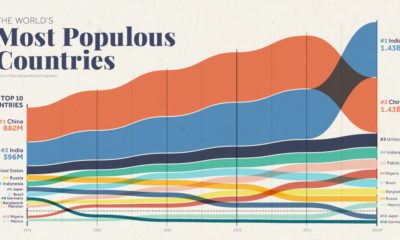While much of this growth has been concentrated in China and India, researchers expect the next wave of growth to occur in Africa. As of 2019, for example, the average woman in Niger is having over six children in her lifetime. At the opposite end of this spectrum are a number of countries that appear to be shrinking from a population perspective. To shed some light on this somewhat surprising trend, we’ve visualized the top 20 countries by population decline.
The Top 20
The following table ranks countries by their rate of population decline, based on projected rate of change between 2020 and 2050 and using data from the United Nations. Many of these countries are located in or near Eastern Europe, for reasons we’ll discuss below. The first issue is birth rates, which according to the Peterson Institute for International Economics (PIIE), have fallen since the collapse of the Soviet Union. Across the region, the average number of children per woman fell from 2.1 in 1988 to 1.2 by 1998. Birth rates have recovered slightly since then, but are not enough to offset deaths and emigration, which refers to citizens leaving their country to live elsewhere. Eastern Europe saw several waves of emigration following the European Union’s (EU) border expansions in 2004 and 2007. The PIIE reports that by 2016, 6.3 million Eastern Europeans resided in other EU states.
The Outliers
There are two geographical outliers in this dataset which sit on either side of Europe.
Japan
The first is Japan, where birth rates have fallen continuously since 1970. It wasn’t until 2010, however, that the country’s overall population began to shrink. By the numbers, the situation appears dire. In 2021, 811,604 babies were born in Japan, while 1.44 million people died. As a result of its low birth rates, the island nation also has the world’s highest average age at 49 years old. The Japanese government has introduced various social programs to make having kids more appealing, but these don’t appear to be getting to the root of the problem. For deeper insight into Japan’s low birthrates, it’s worth reading this article by The Atlantic.
Cuba
The second country is Cuba, and it’s the only one not located within the Eastern Hemisphere. Cuba’s fertility rate of 1.7 children per woman is the lowest in the Latin American region. It can be compared to countries like Mexico (2.2), Paraguay (2.5), and Guatemala (3.0). Cuba’s immigration is also incredibly low compared to its neighboring countries. According to the International Organization for Migration, immigrants account for just 0.1% of its total population. on Even while political regimes across these countries have changed over time, they’ve largely followed a few different types of governance. Today, every country can ultimately be classified into just nine broad forms of government systems. This map by Truman Du uses information from Wikipedia to map the government systems that rule the world today.
Countries By Type of Government
It’s important to note that this map charts government systems according to each country’s legal framework. Many countries have constitutions stating their de jure or legally recognized system of government, but their de facto or realized form of governance may be quite different. Here is a list of the stated government system of UN member states and observers as of January 2023: Let’s take a closer look at some of these systems.
Monarchies
Brought back into the spotlight after the death of Queen Elizabeth II of England in September 2022, this form of government has a single ruler. They carry titles from king and queen to sultan or emperor, and their government systems can be further divided into three modern types: constitutional, semi-constitutional, and absolute. A constitutional monarchy sees the monarch act as head of state within the parameters of a constitution, giving them little to no real power. For example, King Charles III is the head of 15 Commonwealth nations including Canada and Australia. However, each has their own head of government. On the other hand, a semi-constitutional monarchy lets the monarch or ruling royal family retain substantial political powers, as is the case in Jordan and Morocco. However, their monarchs still rule the country according to a democratic constitution and in concert with other institutions. Finally, an absolute monarchy is most like the monarchies of old, where the ruler has full power over governance, with modern examples including Saudi Arabia and Vatican City.
Republics
Unlike monarchies, the people hold the power in a republic government system, directly electing representatives to form government. Again, there are multiple types of modern republic governments: presidential, semi-presidential, and parliamentary. The presidential republic could be considered a direct progression from monarchies. This system has a strong and independent chief executive with extensive powers when it comes to domestic affairs and foreign policy. An example of this is the United States, where the President is both the head of state and the head of government. In a semi-presidential republic, the president is the head of state and has some executive powers that are independent of the legislature. However, the prime minister (or chancellor or equivalent title) is the head of government, responsible to the legislature along with the cabinet. Russia is a classic example of this type of government. The last type of republic system is parliamentary. In this system, the president is a figurehead, while the head of government holds real power and is validated by and accountable to the parliament. This type of system can be seen in Germany, Italy, and India and is akin to constitutional monarchies. It’s also important to point out that some parliamentary republic systems operate slightly differently. For example in South Africa, the president is both the head of state and government, but is elected directly by the legislature. This leaves them (and their ministries) potentially subject to parliamentary confidence.
One-Party State
Many of the systems above involve multiple political parties vying to rule and govern their respective countries. In a one-party state, also called a single-party state or single-party system, only one political party has the right to form government. All other political parties are either outlawed or only allowed limited participation in elections. In this system, a country’s head of state and head of government can be executive or ceremonial but political power is constitutionally linked to a single political movement. China is the most well-known example of this government system, with the General Secretary of the Communist Party of China ruling as the de facto leader since 1989.
Provisional
The final form of government is a provisional government formed as an interim or transitional government. In this system, an emergency governmental body is created to manage political transitions after the collapse of a government, or when a new state is formed. Often these evolve into fully constitutionalized systems, but sometimes they hold power for longer than expected. Some examples of countries that are considered provisional include Libya, Burkina Faso, and Chad.













